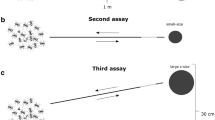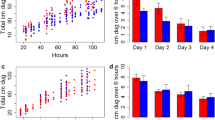Abstract
Many ant species adjust the volume of their underground nest to the colony size. We studied whether the regulation of the volume of excavated sand could result from an interplay between recruitment processes and ant density. Experiments were performed with different group sizes of workers in the ant Messor sancta. When presented with a thin homogeneous sand disk, these groups excavated networks of galleries in less than 3 days. The excavation dynamics were logistic shaped, which suggests the existence of a double feedback system: a positive one resulting in an initial exponential growth phase, and a negative one leading the dynamics to a saturation phase. The total volume of excavated sand was almost proportional to the number of workers. We then developed a model in which we incorporated the quantitative behavioral rules of the workers’ digging activity. A positive feedback was introduced in the form of a recruitment process mediated by pheromones. The model predicts that the excavation dynamics should be logistic shaped and the excavation should almost stop despite the absence of any explicit negative feedback. Moreover, the model was able to reproduce the positive linear relationship between nest volume and colony size.




Similar content being viewed by others
References
Blum MS (1996) Semiochemical parsimony in the Arthropodia. Annu Rev Entomol 41:353–374
Blum MS, Warter SL (1966) Chemical releasers of social behaviour. VII. The isolation of 2-heptanone from Conomyrma pyramica (Hymenoptera: Formicidae: Dolichoderinae) and its modus operandi as a releaser of alarm and digging behaviour. Ann Entomol Soc Am 59:774–779
Bonabeau E, Theraulaz G, Deneubourg J-L, Aron S, Camazine S (1997) Self-organization in social insects. TREE 12:188–193
Brian M (1983) Social insects : ecology and behavioural biology. Chapman & Hall, London
Camazine S, Deneubourg JL, Franks N, Sneyd J, Theraulaz G, Bonabeau E (2001) Self organization in biological systems. Princeton University Press, Princeton
Cassill D, Tschinkel WR, Vinson SB (2002) Nest complexity, group size and brood rearing in the fire ant, Solenopsis invicta. Insectes Soc 49:158–163
Cerdan P (1989) Etude de la biologie, de l’écologie et du comportement des fourmis moissonneuses du genre Messor (Hymenoptera, Formicidae) en Crau. PhD thesis, Université de Provence, Aix-Marseille I
Chrétien L (1996) Organisation spatiale du matériel provenant de l’excavation du nid chez Messor barbarus et des cadavres d’ouvrières chez Lasius niger (Hymenoptera : Formicidae). PhD thesis, Université Libre de Bruxelles, Brussels
Délye G (1971) Observations sur le nid et le comportement constructeur de Messor arenarius. Insectes Soc 18:15–20
Deneubourg JL, Franks NR (1995) Collective control without explicit coding : the case of communal nest excavation. J Insect Behav 4:417–432
Deneubourg JL, Lioni A, Detrain C (2002) Dynamics of aggregation and emergence of cooperation. Biol Bull 202:262–267
Edelstein-Keshet L, Watmough J, Ermentrout GB (1995) Trail following in ants: individual properties determine population behaviour. Behav Ecol Sociobiol 36:119–133
Hölldobler B, Wilson EO (1990) The ants. Springer, Berlin Heidelberg New York
Imamura S (1982) Social modifications of work efficiency in digging by the ant, Formica yessensis Forel. J Fac Sci Hokkaido Univ Ser VI Zool 23:128–142
Jeanson R, Deneubourg J-L, Grimal A, Theraulaz G (2004) Modulation of individual behavior and collective decision-making during aggregation site selection by the ant Messor barbarus. Behav Ecol Sociobiol 55:388–394
Mikheyev AS, Tschinkel WR (2004) Nest architecture of the ant Formica pallidefulva: structure, costs and rules of excavation. Insectes Soc 41:30–36
Rasse P (1999) Etude sur la régulation de la taille et sur la structuration du nid souterrain de la fourmi Lasius niger. PhD thesis, Université Libre de Bruxelles, Brussels
Rasse P, Deneubourg JL (2001) Dynamics of nest excavation and nest size regulation of Lasius Niger (Hymenoptera: Formicidae). J Insect Behav 14:433–449
Sudd JH (1969) The excavation of soil by ants. Z Tierpsyschol 26:257–276
Sudd JH (1970a) The response of isolated digging worker ants [Formica lemani and Lasisus niger] to tunnels. Insectes Soc 17:261–271
Sudd JH (1970b) Specific patterns of excavation in isolated ants. Insectes Soc 17:253–260
Thomé G (1972) Le nid et le comportement de construction de la fourmi Messor ebeninus, Forel (Hymenoptera, Formicoïdea). Insectes Soc 19:95–103
Tschinkel WR (1987) Seasonal life history and nest architecture of a winter-active ant, Prenolepis imparis. Insectes Soc 34:143–164
Tschinkel WR (1999a) Sociometry and sociogenesis of colonies of the harvester ant, Pognomyrmex badius: distribution of workers, brood and seeds within the nest in relation to colony size and season. Ecol Entomol 24:222–237
Tschinkel WR (1999b) Sociometry and sociogenesis of colony-level attributes of the Florida harvester ant (Hymenoptera: Formicidae). Ann Entomol Soc Am 92:80–89
Tschinkel WR (2003) Subterranean ant nests: trace fossils past and future? Palaeogeogr Palaeoclimatol Palaeoecol 192:321–333
Tschinkel WR (2004) The nest architecture of the Florida harvester ant, Pogonomyrmex badius. J Ins Sci 4:21, available online. http://www.insectscience.org/4.21
Wilson EO (1958) A chemical releaser of alarm and digging pheromone in the ant Pogonomyrmex badius (Latreille). Psyche 65:41–51
Wilson EO, Bossert WH (1963) Chemical communication among animals. Recent Prog Horm Res 19:673–713
Acknowledgements
We thank J. Gautrais for his precious advice and programming assistance, and C. Jost, V. Fourcassié, R. Jeanson, J. Le Breton and P. Rasse for many helpful discussions and suggestions. C. Buhl was supported by a doctoral grant from the French Ministry of Scientific Research. J.L. Deneubourg is a research associate of the Belgian National Foundation for Scientific Research. This work was partly supported by the Programme Cognitique from the French Ministry of Scientific Research. Our research complies with the current laws and regulations in France.
Author information
Authors and Affiliations
Corresponding author
Additional information
Communicated by K. Ross
Appendix: description of the model implementation
Appendix: description of the model implementation
At the beginning of a simulation, ants are randomly placed on the surface around the sand disk. All ants start in the free state. During a cycle, each ant is randomly chosen and performs a single action per time step.
Digging and carrying states
If an ant decides to dig, she comes into the digging state for Td time steps; during this period the ant will not perform any other action. When this period of time ends, the ant enters into the transporting state. There exists another way for an ant to come into this state: each time an ant in a free state comes into contact with a pellet, she can pick it up with a constant probability Pp. When an ant is transporting a pellet, she has a constant probability Pd to spontaneously drop the pellet she carries and then enters back into the free state (Fig. 4b).
Ant movements
At the end of a simulation cycle, each ant that has not performed an action (digging, picking or dropping a sand pellet) moves randomly over a distance of one cell, in one of the six possible directions (0°, +/−45°,+/−90° and 180°; see also Fig. 4a) according to a weighted matrix (Md) that favors front directions. The weights applied to each direction are the following: 100 for 0°, 46 for +/−45°, 6 for +/−90°, and 1 for 180°.
The thigmotactic behavior of ants is implemented by weighting the cells, in the matrix Md, that are adjacent to the direction blocked by sand so that the probability to leave the sand wall is equal to the experimental probability (Pl). The movement matrix Md is modified by trail pheromones by adding the pheromone units present in each direction.
An ant cannot move on a cell already occupied by two other individuals. The simultaneous occupation of one cell by two ants was allowed since, in the experiments, we observed that one ant would frequently start to walk over another one when tunnels were crowded. Finally, an ant cannot move on a cell that contains sand and her displacement is restricted by the outside arena.
Evaporation and diffusion of pheromones
At the end of a cycle, evaporation and diffusion processes occur and are applied separately on the two kinds of pheromone. Evaporation is expressed by the following function:
Qt+1is the amount of pheromone in a cell at t+1 after it has lost a fraction of its previous amount Qt; μ is a constant representing the half-life of the pheromone.
Diffusion is implemented in the following way: a fraction of the amount of pheromone Qc on a cell i is diffused to all neighboring cells n,i that have a smaller amount of pheromone Qn,i according to the function:
where D is a constant that represents the diffusion coefficient of the pheromone.
Rights and permissions
About this article
Cite this article
Buhl, C., Deneubourg, J.L., Grimal, A. et al. Self-organized digging activity in ant colonies. Behav Ecol Sociobiol 58, 9–17 (2005). https://doi.org/10.1007/s00265-004-0906-2
Received:
Revised:
Accepted:
Published:
Issue Date:
DOI: https://doi.org/10.1007/s00265-004-0906-2




